Work package 2
A wide range of wound dressings are available and the choice of dressings depends very much on the type of wound. The role of the dressing is to protect the wound, keep the wound moist, adsorb wound exudates, and ideally reduce pain and healing time. Wound dressings based on e.g. collagen and hyaluronic acid can promote healing but are expensive and degrade over time, and is as most other state-of-the-art treatments for non-healing wounds also costly. Traditional wound dressings must be frequently changed, causing severe pain, disruption of the healing process and risks of microbial contamination. This constant management of dressing changes imbues significant costs and resource-use for both patients and healthcare providers.
The aim for WP2 is to develop novel wound dressing materials, that provide a moist and protected microenvironment, reducing pain and that stimulate wound healing. The dressing materials are based on a biosynthetic nanocellulose membrane, and here we present activities for obtaining the dressing materials.
Isolation of cellulose nanomaterials. The evaluation of different raw materials (seaweed, ginger, wood, cellulose pulp), and production methods (chemical and mechanical treatments) for the separation of cellulose nanofibers have been carried out. The main results this far are that TEMPO-mediated oxidation directly from wood powder followed by high-pressure homogenization is the most suitable method to achieve highly functional nanofibers.
Templating cellulose nanofiber networks. Techniques to assemble nanocellulose hydrogels for wound dressing materials have previously been evaluated (3D-printing, vacuum-assisted filtration and solvent casting) and vacuum-assisted filtration have shown to be the best to assemble nanocellulose hydrogels mimicking the properties of BC. Work on characterization of material properties has focused on the structure-property relationship. Nanocellulose have been evaluated according to their dimensions, gel formation ability, chemical composition, reaction yield, surface charge, and degree of oxidation. Main findings are published in Biomacromolecules:
Linn Berglund, Paula Squinca, Yağmur Baş, et al. Self-Assembly of Nanocellulose Hydrogels Mimicking Bacterial Cellulose for Wound Dressing Applications.
Biomacromolecules 2023, 24, 5, 2264–2277.
Yağmur Baş, Linn Berglund, Totte Niittylä et al. Preparation and Characterization of Softwood and Hardwood Nanofibril Hydrogels: Toward Wound Dressing Applications
Biomacromolecules 2023, online November 11.

All HEALiX publications are found under “Publications” in the main menu.
Read more on the other work packages of HEALiX:
WP3 – Embedded wearable sensors
WP4 – Antimicrobial materials
WP5 – Preclinical validation
WP6 – Clinical validation
